
The sights
and sounds of the Jan season
Text &
pics: Lalitha Venkat, Chennai
e-mail: lalvenkat@yahoo.com
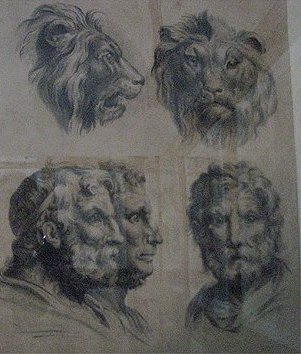 January
26, 2007 January
26, 2007
“Every time you
visit a place, you have to learn something new,” said Prof. Ramanujam.
So, we took his advice, and met Dr. Perumal when we visited the Saraswati
Mahal Library in Thanjavur, recently. It is one among a few medieval libraries
existing in the world, housing about 65,000 books and 49,000 manuscripts
among other treasures. Regaling us with a brief history of Thanjavur, Dr.
Perumal showed us some of these treasures. The library is home to the earliest
printed book of 1692, earliest dated manuscript of 1430, an undated one
belonging to the 11th century, earliest paper manuscript dating to 1476
and the first available catalogue of palm leaf dating to 1801. Around 1981,
the worth of the cloth wraps in which the manuscripts had been preserved,
was discovered by a research scholar from overseas, after which the available
cloth wraps were rescued from wherever they had been discarded out of sheer
ignorance. Some were even being used as rags! The enemies of books and
manuscripts are dust, light, heat and humidity. Dr. Perumal gave us a tip
to keep away insects and mould. Just scatter bits of the herb vasambu (in
Tamil) in your bookshelves and cupboards. Red is the dominant color used
in the paper, cloth wrap and binding to repel insects and yellow serves
as a disinfectant.
In the little
museum, what interested me most were the lithographic pictures by Charles
Le Brun, a physiognomist and court artist at the time of the French King
Louis XIV. His Human Physiognomy Charts depicting human faces resembling
relevant birds and beasts are outstanding.
At the Brihadeeswara
temple itself, it was interesting to explore the Buddhist connection and
locate the Buddha reliefs with an old article from The Hindu as guide!
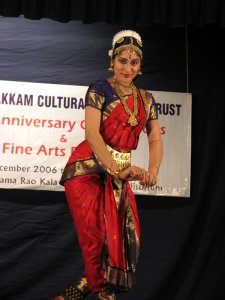 Janaki
Rangarajan
Janaki
Rangarajan
|
Janaki Rangarajan,
a senior disciple of Padma Subrahmanyam presented a Bharatanrityam recital
for Numgambakkam Cultural Academy on Jan 2. A Balamuralikrishna composition
in ragamalika and talamalika for Pushpanjali, Thirupugazh verses for alarippu,
a composition of Venkatrama Sastri in ragam Husseini for varnam, “Krishna
nee begane…” in raag Yamankalyan, a Jayadeva ashtapadi in raag Basant Bahar,
and a thillana composed by the Tanjore Quartette were the items she presented
for the evening’s recital. She was accompanied by Jayashree Ramanathan
on nattuvangam, G Srikanth on vocal, SSR Krishnan on mridangam and S Vijayaraghavan
on violin. On previous visits, Janaki has performed items choreographed
by her guru, but this time she performed items that she has choreographed
herself. It was a very small audience that she danced to, but for Janaki,
“One of the most valuable things that I have learnt during these years
is that every performance is extremely important and the performer’s enthusiasm
or quality should not vary depending on the audience or the venue.” Dancing
in Chennai makes Janaki feel completely satisfied, encouraged and creatively
challenged. Being a part of the Marghazhi Mahotsavam is truly invigorating
and a dream come true for her.
The Music Academy
hosted its dance festival from Jan 1 to 9 where all the prominent artistes
of Chennai were featured in 4 programs a day. Jan 5 started with a lec-dem
and performance of ‘Neelam’ by Anita Ratnam. She spoke about her various
teachers and what she imbibed from each one of them, about her training
in Bharatanatyam, Mohiniattam and especially Kathakali, which strengthened
her dance movement vocabulary. She reminisced about compositions that were
done specially for her and her sister Pritha by vidwan Madurai N Krishnan
as well as the famous Nandichollu that Trichur Ramanathan composed in her
house! She quit dancing for 10 years to concentrate on her television work
in the US, but when she returned to India in 1992 to start Arangham Trust,
she was inspired by her mentor Sudharani Raghupathy’s research into Vaishnava
traditions. Combined with impetus from Prof. Ramanujam, she did research
on Arayar Sevai and worked hard to revive the Kaisiki Natakam ritual tradition
of the Nambi temple in her ancestral town Thirukurungudi. With support
of family, friends and well-wishers, she helps conduct the annual Kaisiki
Natakam at Thirukurungudi every December, for the past 8 years.
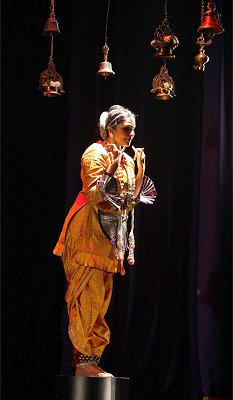
|
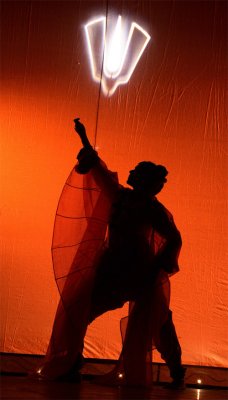
|
|
Anita
Ratnam
Pics:
Chella
|
|
The dance movements
and music for ‘Neelam’ is inspired by her research. Anita pays special
attention to costume, music, lighting and backdrop. For Neelam, she recorded
the announcements along with the music, so there is no break in the continuity.
In the first half of the program, she wears a startling androgynous yellow/pitambara
costume designed by Rex. This against the beautiful stage design also by
Rex with Vaishnavite symbols and suspended temple bells is an example of
how she conceives a show in its totality. Thus, the meditative quality
of watching a performance of Neelam is like being transported to the precincts
of a Vaishnavite shrine.
With the new
administration in place at the Music Academy, changes are already being
felt this past season, like giving more importance to dance. “Like all
mainstream theatres around the world, I would like to see the Academy develop
a year round series of programs where people can get to see the best of
classical and contemporary performances in music, dance and theatre in
frequent showcases,” says Anita, whose grandfather TS Rajam was a president
of the Music Academy!
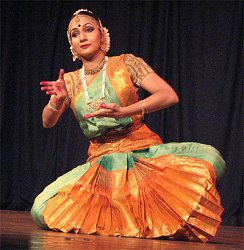 Neeraja
Srinivasan
Neeraja
Srinivasan
|
Why did Neeraja
particularly choose to do Dikshitar compositions? “I believe that every
artist, why, every living being strives to reach its greatest potential
during its life span. Personally, I have for several years and still am
trying to reach out for that goal of completion through my dance. I have
danced to several compositions, old and new; contemporary and traditional;
of different hues and moods, to discover that energy which will take me
beyond my very existence. I found this elevation in Muthuswamy Dikshitar's
sublime compositions. For someone who is not much into prayer or rituals,
I found my self and my god in his words. In fact, I need to consciously
and quite reluctantly pull myself back on stage when I dance to his compositions
as my mind tends to become one with his music and float away. Hence I wanted
to dedicate one of my recitals to Dikshitar, who was gifted to us so long
ago and who still reigns in our hearts.”
What does this
Chennai season mean for young dancers like Neeraja? “Every season we have
dancers and musicians complaining about the commercialization of art and
opportunities not being given to talented artists. Indeed, dancers do have
to spend a lot in order to perform. It's tough, yes, but Chennai's Margazhi
season is special, unique and wonderful. It gives me a thrill to read the
season's first Sabha schedule, make a mark against my favorite artists
and decide what to wear! It is a month long party in Chennai when the city
and especially Mylapore, my home turf, becomes obsessed and fanatical about
music, dance, lec-dems, harikathas! The season is great education for artists.”
About performing
to a sparse audience after all the hard work, Neeraja says, “Dance itself
is its greatest reward. A good responsive crowd, of course is a great motivator.
A kutcheri is, after all, an interaction of energy between the dancer and
her/his audience. I always believe that good work will get good response.
I have seen it happen. The better my work, the better the audience and
their feedback.” Incidentally, she holds a regular job to support her dance
career!
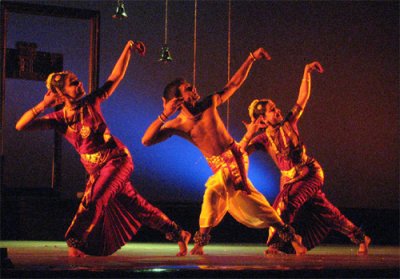 Aishwarya
Nityananda, Parshwanath Upadhya and Padmini Upadhya
Aishwarya
Nityananda, Parshwanath Upadhya and Padmini Upadhya
|
 Anuradha
Vikranth
Anuradha
Vikranth
|
The festival scene
shifted to Bangalore for the second edition of the Drishti Festival at
the Chowdiah Hall on Jan 12 organised by the Drishti Art Foundation. The
hall overflowed with people eventually standing on the sides, sitting in
the aisle space or even watching from the wings! The program commenced
with young talents Aishwarya Nityananda, Padmini Upadhya and Parshwanath
Upadhya performing Pushpanjali, Ganapathi sthuthi and Eesham Sarvesham
choreographed by Anuradha Vikranth. Anuradha then presented Nrithonnathey
(one who is engrossed in dance). One of the most accomplished male dancers
of India, Sathyanarayana Raju gave a memorable presentation of the lengthy
varnam Devadideva Nataraja, a composition of Veenai Sesha Iyer. He
got wonderful accompaniment with guru Narmada on nattuvangam, Gurumurthy
on mridangam, Srivatsan on vocal and Mahesh Swamy on flute. The Drishti
Trio of Anuradha, Shama and Sanjay presented Rhythms in a blend of classical,
contemporary and folk beats that did not quite take off. The Kirans presented
slokams on Devi, Nataraja and a thillana composition of Lalgudi Jayaraman.
While the other dancers had covered the stage space very well, the Kirans
were a bit too static and the orchestra too loud. The final performance
was an energetic whirl of movements by Madhu Nataraj and the gifted dancers
of Stem Dance Kampni, starting with Ushas that had a dramatic fire background.
The Sports Sequence created specially for Suvarna Karnataka with music
by Praveen Rao, was a big hit with the audience. As people started to leave
and the felicitation ceremony also was due, Madhu Nataraj had to cut short
an item and the group finished with a Tarana. Excellent lighting by Sai
Venkatesh was a plus point of the festival.
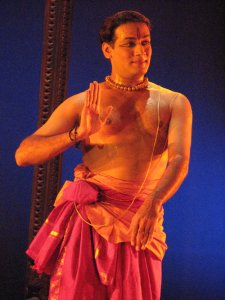 Sathyanarayana
Raju
Sathyanarayana
Raju
|
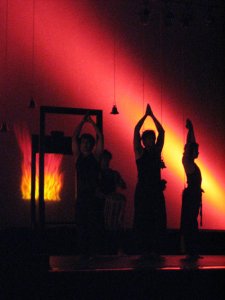 Stem Dance
Kampni
Stem Dance
Kampni
|
Drishti honored
Kathak guru Maya Rao and Bharatanatyam guru/scholar Leela Ramanathan for
their contribution to the dance field. “There are so many associations
for critics, writers, actors and so on, but no association for dancers.
Envy could be one reason. We hope to see a dancers association in the future.
It is nice to see youngsters presenting other youngsters, something Leela
and I never had in our younger days. Awards are not important. It’s a greater
reward that young dancers recognize our contribution,” said guru Maya Rao.
Leela Ramanathan agreed with that, adding, “Getting other young dancers
to share a platform without envy is commendable. Maya and I felt the desire
to dance, so we danced, not for any rewards.” Guru Narmada was specially
felicitated with the happy announcement that she has been nominated for
the Sangeet Natak Akademi Award.
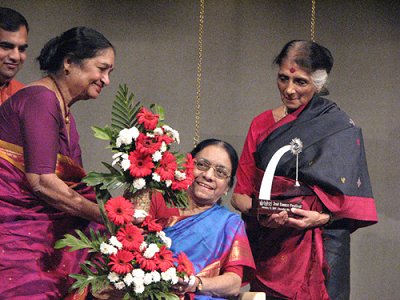 Gurus
Maya Rao, Narmada and Leela Ramanathan
Gurus
Maya Rao, Narmada and Leela Ramanathan
|
After seeing so
many near empty halls in Chennai, it was heartening to see full house at
Chowdiah, a cheerful sight for any performer. However, the program sequence
and artiste lineup could have been made more compact, with the hosts performing
in the end, if at all they must perform. After all, the main idea is to
give a platform to other young talent of Bangalore. Also, the felicitation
function should have been conducted earlier in the evening and not when
half the hall was empty. As Anuradha Vikranth admits, conducting a festival
is not an easy task and she hopes to do better in forthcoming festivals.
She feels the atmosphere for dance in Bangalore is good, with fairly good
performance opportunities in general. Anuradha plans to present artistes
from Karnataka for the next two festivals before venturing into inviting
artistes from outside Karnataka.
|

